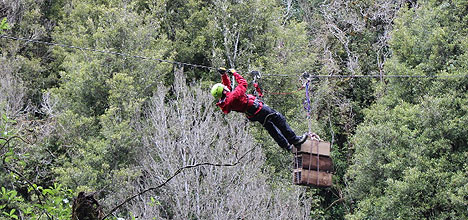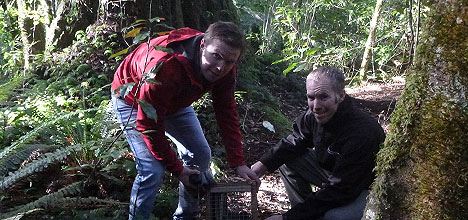More than three tonnes of pests are expected to be wiped out in an intense, week-long conservation effort taking place across 50 hectares of native forest near Rotorua.
As part of preparations for Conservation Week, starting in September, 500 traps have been flown into the area, via zip line, and are being laid over a 10 kilometre trapping line network within the dense native scenic reserve. It is hoped stoats, rats and possums will be wiped out as a result.
Rotorua Canopy Tours director James Fitzgerald and DOC representative Rob Griffiths inspecting the traps. Source: Rotorua Canopy Tours.

Rotorua Canopy Tours conservation manager Gary Coker zip lining in 200 DOC stoat traps. Source: Rotorua Canopy Tours.
The area will be pre-fed for the next six weeks in the hope of maximising results when the traps are set live on Sunday, September 8 – coinciding with the first day of Conservation Week.
The eradication process is funded and managed by Rotorua Canopy Tours, operating a zipline tourism venture throughout the canopy, and supported by the Department of Conservation (DOC) which manage the reserve.
The operation is part of a three-stage project aiming to reduce the volume of pests decimating local flora and fauna.
Rotorua Canopy Tours director and manager of the trapping operation James Fitzgerald says the decimation of native forest and the wide-scale death of native wildlife caused by pests – in particular stoats, rats and possums – is a major issue for New Zealand.
'We want to raise awareness even further about the true impact of pests on our native animals and plants. This is a huge problem and the numbers are mind-boggling. Landcare Research estimates that 26 million native birds are killed annually. That equates to approximately 70,000 per night. Only five per cent of native chicks are making it to adulthood in areas where there is no pest control.
'We have worked closely with DOC on this project and taken their advice about the traps, pre-feeding; and the best way of maximising the effects of the activity. By removing a large volume of pests just prior to spring, we will create a safer breeding ground and environment for chicks to grow and gain flight. Once the birds are mobile, they have a far greater chance of survival and thus re-population,” says James.
The operation's main goal is to significantly reduce pest numbers, along with returning – where possible – the forest back to its pre-human state for New Zealanders and tourists to enjoy.
The three-stage project will roll out during the next five years, with pest control equipment installed across a further 200 ha – and finally across the entire 500 ha reserve.
DOC Rotorua Lakes Area community relations ranger Rob Griffiths says that the department is thrilled with Rotorua Canopy Tours' pest control programme.
'We applaud this programme. This is a great example of a business working in partnership with DOC to achieve significant conservation gains,” says Rob.
'James and his team at Rotorua Canopy Tours are investing in a pest control programme that will enable the native forest and wildlife in this reserve to recover from the damage done by introduced pests.
'The scope of the company's vision to control pests throughout the 500 ha reserve is fantastic, and we're delighted to be working with James and his team on this significant conservation initiative,” says Rob.
The extremely time and labour-intensive operation has been funded through donations, and from a portion of the commercial zip line operation admission costs.
Canopy Tours staff will monitor and re-set the pest-specific traps daily, and provide updates to DOC.
Only traps providing humane and instant kill results will be used in the conservation exercise.



1 comment
Comparison?
Posted on 06-07-2013 16:32 | By Plonker
Rotorua has Eradication, Tauranga has Proliferation? Is there a common thread here? Perhaps the vermin have made the exodus and likely reside at Tauranga "holiday camp" City "Hi-dee-hi" Council "village" chambers.
Leave a Comment
You must be logged in to make a comment.